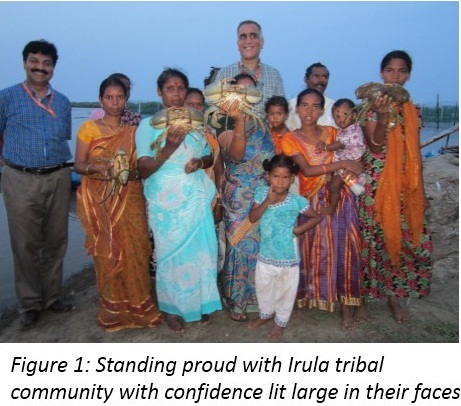LIVELIHOOD

On a typical day of May, when many parts of the country are in the midst of heatwaves and scorching sun; we decided to visit one of our post tsunami livelihood intervention in coastal Tamil Nadu. In the aftermath of Tsunami, lives were lost and livelihood destroyed of many poor and marginalized communities living in the coastal area. Rebuilding lives and providing sustainable livelihoods options, especially to those at the margins (poor tribal women) was a priority for CARE India. It is in this context, CARE India started an intervention focused on crab culture for Irula tribal women (a tribal communities identified with snake catching to make ends meet) in 2008-09 in the backwaters of Cuddalore district in Tamil Nadu.
It was heartening to see that even though in 2011 CARE India had completely handed over the project to the communities; tribal women are enthusiastically involved in culturing crab in artificial pens. We were amazed to see and learn that coastal delicacy being reared from seed to full grown (as big as a kilo and half!) with lucrative profits and a good part is that the income is ploughed back into the kitty of tribal women. This regular source of income has led to qualitative changes in their lives as it has not only provided them with income security but also enhanced their social position. Their children are in schools, women are visiting hospitals regularly, and women are better able to negotiate with markets- be it commodity, banks, government or any other service provider. For the community, that few years back used to live in igloo type of tenement with low roofing, a concrete house with a toilet is an issue of great presitge. Uthira, a tribal women feels proud that other communities now invite the Irula’s for family function- earlier a social taboo. With lively interaction with other communities in the village, Uthira is now a happy mother as she now sees that her children are like any other children in the village.

Looking back, in six years the project has provided extra income and social prestige to the family and the wider community. To the women, it has provided economic security, enhanced their confidence, and reinforced their position within the household. All this has led to women confidently negotiating price for harvested crabs with the traders- a far cry from six years back- when communities were forced to sell their crab harvest at throwaway prices to unethical traders, when children and women used to wade neck deep through the backwaters unmindful of potential health hazards. At such moment, it becomes clear that weaving in component of sustainability can pay rich dividends.
The community that I see now is a more resilient community than it was in the aftermath of Tsunami, with things in place to withstand any future shocks. What is more heartening to see is the visible sign of social resilience- the confidence to stand with other community.
Today the Irula community is a mainstreamed community- the reason behind it has to be found in an integrated approach to shelter, advancing livelihoods outcomes, improving adult functional literacy, improving water and sanitation, and building awareness on social issues. I came back realizing that this is something we need to be proud of.




